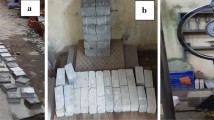Abstract
In this study, the rate of heat evolution curve obtained from isothermal calorimetry is used for predicting the setting time. A derivative curve plot from the rate of heat evolution was used to determine the initial setting time (IST) and final setting time (FST) of cement paste and mortar containing different w/c ratio. Also, conventional methods such as IS 4031(part-5) and ASTM C403 were taken to determine the setting times. The correlation was developed between setting time obtained from the derivative plot and IS 4031 for cement paste sample, and derivative plot and ASTM C403 for mortar samples. The study indicates that the isothermal calorimetry techniques can be used to determine the setting time with ± 0.37–4.48 h deviation for cement paste and ± 0.43–3.78 h for the mortar, regardless of IST and FST. Further, a very high coefficient of correlation with 0.95 for IST and 0.99 for FST was obtained. Besides, longer setting times were obtained from the calorimetry method as to IS and ASTM setting time method.
Access this chapter
Tax calculation will be finalised at checkout
Purchases are for personal use only
Similar content being viewed by others
References
Mehta PK, Monteiro PJM (2006) Concrete microstructure, properties, and materials. McGraw-Hill
Neville AM, Brooks JJ (1987) Concrete technology. Longman Scientific & Technical, England
Frølich L, Wadsö L, Sandberg P (2016) Cement and concrete research using isothermal calorimetry to predict one day mortar strengths. Cem Concr Res 88:108–113. https://doi.org/10.1016/j.cemconres.2016.06.009
Suraneni P, Weiss J (2017) Examining the pozzolanicity of supplementary cementitious materials using isothermal calorimetry and thermogravimetric analysis. Cement Concr Compos 83:273–278. https://doi.org/10.1016/j.cemconcomp.2017.07.009
Ge Z, Wang K, Sandberg PJ, Ruiz JM (2009) Characterization and performance prediction of cement-based materials using a simple isothermal calorimeter. J Adv Concr Technol 7(3):355–366
Hu J, Ge Z, Wang K (2014) Influence of cement fineness and water-to-cement ratio on mortar early-age heat of hydration and set times. Constr Build Mater 50:657–663. https://doi.org/10.1016/j.conbuildmat.2013.10.011
Sandberg JP, Liberman S (2007) Monitoring and evaluation of cement hydration by semi-adiabatic filed calorimetry. In: Wang K, Schindler AK (eds) Concrete heat development: monitoring, Prediction, and Management Georgia NY: Curran Associates, IN, pp 13–24
Pang X, Bentz DP, Meyer C, Funkhouser GP, Darbe R (2013) Cement and concrete composites a comparison study of Portland cement hydration kinetics as measured by chemical shrinkage and isothermal calorimetry. Cement Concr Compos 39:23–32. https://doi.org/10.1016/j.cemconcomp.2013.03.007
IS 383 (2016) Coarse and fine aggregate for concrete- specification
ASTM C1702 (2013) Standard test method for measurement of heat of hydration of hydraulic cementitious materials using isothermal conduction. West Conshohocken, PA. https://doi.org/10.1520/C1702-13
ASTM C1679 (2014) Standard practice for measuring hydration kinetics of hydraulic cementitious mixtures using isothermal calorimetry. ASTM International, West Conshohocken, PA. https://doi.org/10.1520/C1679-14
ASTM C403, “ASTM C 403 (2005) Standard test method for time of setting of concrete mixtures by penetration resistance. ASTM C 403–95, Annual Book of ASTM Standards, American Society for Testing and Materials, Pennsylvania, 1998. ASTM, pp 1–7. https://doi.org/10.1520/C0403
Arora A, Sant G, Neithalath N (2016) Ternary blends containing slag and interground/blended limestone: hydration, strength, and pore structure. Constr Building Mater 102:113–124. https://doi.org/10.1016/j.conbuildmat.2015.10.179
Bentz DP (2006) Influence of water-to-cement ratio on hydration kinetics: simple models based on spatial considerations. Cem Concr Res 36(2):238–244. https://doi.org/10.1016/j.cemconres.2005.04.014
Langan BW, Weng K, Ward MA (2002) Effect of silica fume and fly ash on heat of hydration of Portland cement. Cem Concr Res 32(7):1045–1051. https://doi.org/10.1016/S0008-8846(02)00742-1
Bentz DP, Barrett T, De I, Weiss WJ (2012) Relating compressive strength to heat release in Mortars. Adv Civil Eng Mater 1(1):1–14. https://doi.org/10.1520/ACEM20120002
Frølich L, Wadsö L, Sandberg P (2016) Using isothermal calorimetry to predict one day mortar strengths. Cement Concr Res 88:108–113. https://doi.org/10.1016/j.cemconres.2016.06.009
Acknowledgements
The authors thank Aamna Sarfaraz for providing a quick check with the English language that was used in the paper. I also thank the technical staff from the Structural Engineering Laboratory, IIT Kanpur.
Author information
Authors and Affiliations
Editor information
Editors and Affiliations
Rights and permissions
Copyright information
© 2022 The Author(s), under exclusive license to Springer Nature Singapore Pte Ltd.
About this paper
Cite this paper
Vishavkarma, A., Harish, K.V. (2022). Using Isothermal Calorimetry to Predict Setting Time of Cement-Based Materials (CBMs). In: Laishram, B., Tawalare, A. (eds) Recent Advancements in Civil Engineering. ACE 2020. Lecture Notes in Civil Engineering, vol 172. Springer, Singapore. https://doi.org/10.1007/978-981-16-4396-5_31
Download citation
DOI: https://doi.org/10.1007/978-981-16-4396-5_31
Published:
Publisher Name: Springer, Singapore
Print ISBN: 978-981-16-4395-8
Online ISBN: 978-981-16-4396-5
eBook Packages: EngineeringEngineering (R0)




